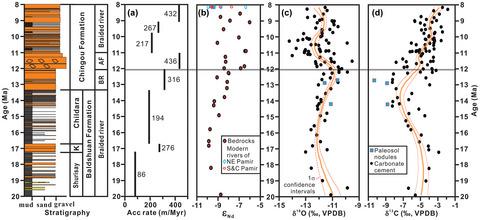当前位置:
X-MOL 学术
›
Basin Res.
›
论文详情
Our official English website, www.x-mol.net, welcomes your feedback! (Note: you will need to create a separate account there.)
Middle to late Miocene growth of the North Pamir
Basin Research ( IF 3.2 ) Pub Date : 2021-10-26 , DOI: 10.1111/bre.12629 Lin Li 1, 2, 3 , Guillaume Dupont‐Nivet 1, 4 , Yani Najman 5 , Mustafa Kaya 4 , Niels Meijer 4 , Marc Poujol 1 , Jovid Aminov 6, 7
Basin Research ( IF 3.2 ) Pub Date : 2021-10-26 , DOI: 10.1111/bre.12629 Lin Li 1, 2, 3 , Guillaume Dupont‐Nivet 1, 4 , Yani Najman 5 , Mustafa Kaya 4 , Niels Meijer 4 , Marc Poujol 1 , Jovid Aminov 6, 7
Affiliation

|
How and when the Pamir formed remains an open question. This study explores Pamir tectonics recorded in a sedimentary section in the eastern Tajik Basin. A prominent lithofacies change that has been recognised regionally is assigned to the middle Miocene (13.5 Ma based on preferred magnetostratigraphic correlation). Closely following this change, detrital zircon U-Pb age spectra and mudstone bulk-rock εNd values exhibit a sediment source change from the Central to the North Pamir estimated ca. 12 Ma. At the same time, the stable oxygen and carbon isotopic values of carbonate cements show negative and positive shifts, respectively. Combined with previous studies in both the Tajik and Tarim basins, these results suggest that the North Pamir experienced a middle–late Miocene phase of deformation and surface uplift. This supports models proposing middle–late Miocene Pamir tectonism, and climate models implying that coeval Pamir orogenesis deflected Westerly moisture and affected Asian environments.
中文翻译:

北帕米尔中新世中晚期生长
帕米尔高原如何以及何时形成仍然是一个悬而未决的问题。本研究探讨了塔吉克盆地东部沉积剖面中记录的帕米尔构造。已在区域内识别的显着岩相变化被分配到中中新世(13.5 Ma,基于首选的磁地层相关性)。紧随这一变化,碎屑锆石 U-Pb 年龄谱和泥岩块状岩石ε Nd值显示从中央到北帕米尔的沉积物来源变化估计约。12 马。同时,碳酸盐胶结物的稳定氧同位素值和碳同位素值分别呈现负移和正移。结合之前对塔吉克盆地和塔里木盆地的研究,这些结果表明北帕米尔地区经历了中新世中晚期的变形和地表抬升阶段。这支持提出中新世中晚期帕米尔构造运动的模型,以及暗示同时期帕米尔造山运动使西风湿气偏转并影响亚洲环境的气候模型。
更新日期:2021-10-26
中文翻译:

北帕米尔中新世中晚期生长
帕米尔高原如何以及何时形成仍然是一个悬而未决的问题。本研究探讨了塔吉克盆地东部沉积剖面中记录的帕米尔构造。已在区域内识别的显着岩相变化被分配到中中新世(13.5 Ma,基于首选的磁地层相关性)。紧随这一变化,碎屑锆石 U-Pb 年龄谱和泥岩块状岩石ε Nd值显示从中央到北帕米尔的沉积物来源变化估计约。12 马。同时,碳酸盐胶结物的稳定氧同位素值和碳同位素值分别呈现负移和正移。结合之前对塔吉克盆地和塔里木盆地的研究,这些结果表明北帕米尔地区经历了中新世中晚期的变形和地表抬升阶段。这支持提出中新世中晚期帕米尔构造运动的模型,以及暗示同时期帕米尔造山运动使西风湿气偏转并影响亚洲环境的气候模型。



























 京公网安备 11010802027423号
京公网安备 11010802027423号